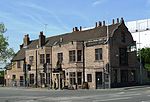Uxbridge Vine Street railway station
Disused railway stations in the London Borough of HillingdonFormer Great Western Railway stationsFormer buildings and structures in the London Borough of HillingdonLondon railway station stubsPages with no open date in Infobox station ... and 4 more
Railway stations in Great Britain closed in 1964Railway stations in Great Britain opened in 1856Use British English from March 2018Uxbridge

Uxbridge Vine Street station opened on 8 September 1856 as Uxbridge Station and was the earliest of three railway stations in Uxbridge, London.
Excerpt from the Wikipedia article Uxbridge Vine Street railway station (License: CC BY-SA 3.0, Authors, Images).Uxbridge Vine Street railway station
Vine Street, London
Geographical coordinates (GPS) Address External links Nearby Places Show on map
Geographical coordinates (GPS)
| Latitude | Longitude |
|---|---|
| N 51.5444 ° | E -0.4791 ° |
Address
Uxbridge Vine Street
Vine Street
UB8 1JG London (London Borough of Hillingdon)
England, United Kingdom
Open on Google Maps










